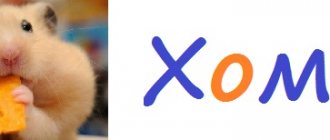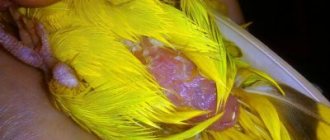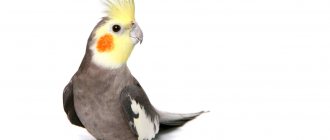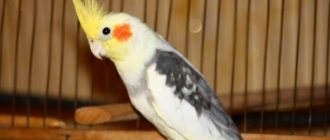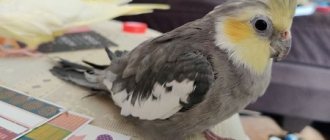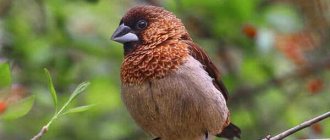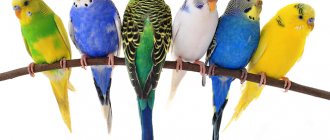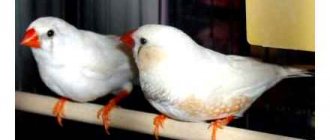Very often, parrot breeders acquire this or that type of bird without bothering to first study their habits and disposition. In this case, an inexperienced pet lover runs the risk of constantly encountering some uncharacteristic or unusual phenomena that baffle him.
In this article we will try to pay attention to only one species of bird - the cockatiel parrot. And consider one frequently asked question - why can a cockatiel sometimes lay one egg without a male?
This choice fell on cockatiels for a reason. After all, they are one of the most common bird species for domestication. And cases when a female cockatiel lays eggs without a pair are not so rare. However, let's not get too far ahead and consider everything in order.
Can a female cockatiel lay an egg without a male?
For domestic breeding birds, this phenomenon is considered absolutely normal. They can safely lay eggs almost every day and the presence of a male is not a prerequisite for this. For nesting birds, laying eggs is a complex process. During this period, they spend a large amount of minerals and therefore try to do this only in the most favorable conditions.
Just like broodbirds, nesting cockatiels can lay eggs without a male. You just have to understand that chicks will not appear from such eggs. For fertilization and the birth of offspring, the participation of a male individual is still necessary.
Corella and her eggs.
Jaco
Large parrots breed in aviaries.
It is advisable to provide the couple with free movement from the cage to the room. If you choose a partner successfully, during the nesting season you can see a mating ritual that lasts several days. 2-3 weeks after the mating ritual, the female lays 3-4 eggs in the nest, the intervals between laying eggs are 2 days. The female incubates the clutch for a month. After 2 months (or a little more), the chicks leave the nest and begin to fly. Young parrots should not be separated at this time, as they will still need the help of their parents for some time. Young parakeets can remain in the same cage with their parents until the next nesting season. With proper care, Gray parrots can live up to 100 years.
How to understand that a cockatiel wants to lay an egg
When people get one parrot, they are not particularly interested in the processes of their reproduction and therefore most likely will not understand that their feathered pet is preparing for procreation.
The behavior of the female at this moment differs from usual and can alert a person.
Change in Behavior
A cockatiel that is about to lay an egg begins to behave very restlessly. She begins to rush around the cage, scream loudly and constantly flutter from one surface to another. At the same time, if the parrot is tame and trusts its owner, then it will be happy to be held and show special love and affection.
Changes in stool
Another sign of impending oviposition is the stool of a feathered pet. The developing egg begins to put pressure on the intestines, feces accumulate and, as a result, the parrot leaves behind unusually large, semi-liquid puddles.
Timing of behavior change
Such throwing of the female can last from several minutes to an hour, depending on the physiological characteristics of each particular bird.
Masonry
Eventually, the cockatiel will usually choose a suitable surface, such as the bottom of the cage, and lay its first egg. Over the next few days, the female will likely lay several more eggs.
Possible problems
During the breeding process of the cockatiel parrot, some problems may arise. Most of them can be corrected with medication, however, in some cases (mostly advanced) serious surgical intervention is necessary. Among them:
Eggs stuck
This disease occurs due to exhaustion of the feathered friend’s body. This usually happens with small cockatiels.
When eggs get stuck, the bird's cloaca swells and constipation occurs. It becomes noticeable that she often sits on the floor without purpose or movement (parrots are active at any period of their life, insufficient activity should be alarming in any case). Sometimes malfunctions in the functioning of the digestive and excretory systems also occur, breathing becomes difficult and becomes more frequent.
To get rid of this problem, the bird needs to be heated. This can be done using a 40–60 Watt lamp or a heating pad.
In advanced cases, you will certainly have to consult a surgeon. The attentiveness and vigilance of the owner is important here.
egg binding
This happens when a bird has slow movement of eggs in the oviduct. This is caused by a lack of nutrients in the feed and ailments of the ovipositor system.
You can notice such a nuisance by the condition of the bird. If a bird twitches its tail, is constantly exhausted and irritated, this is already a reason to sound the alarm. Sometimes when the eggs are tied, the belly swells and the paws fail.
If egg binding is noticed at an early stage, it is possible to “get off” by washing the uterus. If this problem reappears or in more advanced cases, the bird’s uterus is surgically removed. This is quite unpleasant, because in this case the female will never be able to bear offspring again.
Prolapse of the inflamed cloaca and uterus
One of the most terrible problems is prolapse of the cloaca and uterus. This problem may be associated with obesity, malnutrition, too large an egg in the bird's body (or an incorrect shape), or weakening muscle tissue.
This is noticeable due to a decrease in activity. When such a sign is noticed, you can already notice a red lump or protruding organs on the anus.
If the prolapsed organs are not damaged, it is possible to set them back. This is done after treatment with chlorhexine and inserted with a tampon soaked in an iodine solution. Often you have to contact surgeons. Re-breeding a bird that has encountered such an illness may be almost impossible.
Oviduct rupture
The most terrible problem that can arise during masonry. The rupture of the oviduct is associated with constant tension in the bird’s body. This tension can be caused by eggs getting stuck or tied up.
You can notice a gap if the bird is quickly losing weight, but at the same time its belly is increasing in size. This is noticeable when observing the gait of a bird - it changes significantly.
At the initial stage of this disease, you can get rid of it by taking antibiotics, but in most cases you have to surgically remove the bird’s oviduct.
Why does a cockatiel lay eggs without a male?
In the natural Australian environment, cockatiels most often begin to lay eggs during the warm summer rainy season. This period is the most suitable for them, given the combination of such conditions:
- comfortable air temperature;
- sufficient drinking water;
- abundance of plant food.
This environment allows the birds to timely replenish the reserves of missing minerals from food, so females often enter into a long, continuous process of reproduction. One cockatiel nest can contain both already hatched chicks and eggs from a new clutch. For the females themselves, such a long-term load on the body is very dangerous, but during this period they are guided only by natural instinct and try to give as many offspring as possible before the onset of cold weather or drought.
Female cockatiels living in captivity are guided by exactly the same instincts, so the appearance of an unfertilized egg in a cage is rather a good sign . This indicates that the bird feels as comfortable as possible, is safe and receives a balanced diet, including all the necessary vitamins and minerals.
Corella and offspring.
Electric models
Beginners should pay attention to more innovative gadgets. They are definitely a little more expensive
But in this case, the price increase proportionally affects safety.
We are talking about a family of rechargeable machines equipped with a rotating head. They do not cut, but grind down the cornea. With this approach, it is almost impossible to harm a dog or cat by catching too much of a nail. The high rotation speed of the tip ensures fast operation, and the low noise level does not bother four-legged patients at all. Any beginner can easily cope with such a mechanism.
Price – 481 – 1,859 rubles.
Some models are equipped with 2-3 heads, suitable for dogs or cats of various breeds and age groups.
After all, the claws of a dwarf poodle are much more delicate than those of a German shepherd. The same applies to young kittens and adult cats - their paws need to be treated with different elements. So, when purchasing a tool for trimming claws, you should consider this nuance.
Cost – 567 – 1,189 rubles.
The final touch is the rotation speed of the device head.
It directly affects the quality of claw grinding. After all, it is necessary not only to cut off the ends, but also to polish the ends so that the sharp edges do not injure the delicate pads of the paws. This operation is best done in a more gentle mode at low speeds. So a machine with gear shifting will come in very handy in this case.
Price – 497 – 1,566 rubles.
I like it I don't like it
What to do if a female cockatiel laid an egg without a male
If the female has already laid her first egg, she will soon sit on it and begin to incubate it. Of course, this will not give results, but that’s how nature works. Next, the owner has two options: remove all laid eggs from the cage or give the female the opportunity to incubate.
Removing eggs from the cage
This option is suitable for those who do not plan to breed chicks in the future.
Regular removal of new eggs can confuse the bird, and in some cases it even stops laying them earlier than expected.
Such actions do not have a particularly good effect on the emotional state of the parrot and disrupt the natural cycle. In the future, this may adversely affect the perseverance of the female and obtaining offspring from her will become problematic.
Despite all the disadvantages, this method is strongly recommended for those birds that spend most of their time in a cage. Sedentary parrots in most cases are not in the best physical shape and laying eggs can be dangerous for them. Passive birds are more prone to pathologies such as:
- prolapse of the uterus or part of the inflamed cloaca;
- egg stuck;
- rupture of the oviduct;
- egg binding.
Keeping eggs in a cage until the end of hatching
This method is considered more friendly to the bird. This way she will satisfy her natural instincts and will not experience unnecessary stress.
| Eggs in a clutch | Corella can lay up to 2 eggs per day. The number of eggs in one egg laying is on average 4-5 pieces. |
| Creating a Nest | To make the bird comfortable, you can equip it with a small temporary nest made of small sawdust, in which it will incubate the laid eggs. |
| What to do with eggs | The entire incubation process usually takes 19-21 days, from the moment the first egg appears. Since there is no point in hatching unfertilized eggs, after about 10-15 days, you can gradually remove eggs from the nest, 1-2 per day. |
| Feeding | To maintain your pet’s health, you should add special preparations to the diet that contain all the necessary vitamins and minerals. |
| Regulation of masonry | To ensure that the next incubation of eggs does not cause the cockatiel to become exhausted, you should not allow more than 2 egg layings per year. |
| Things to consider | The only disadvantage of this method is the load on the body, since in order to form an egg, the bird gives up a considerable part of the nutrients from its personal reserves. |
Matching
Breeding cockatiels at home attracts many owners of exotic birds. They breed easily in captivity. Different clutches of the same cockatiel always differ from each other. Chicks are born with different colors of feathers and eyes, and the sizes of small parrots also vary.
Selection conditions
In the wild, Corella parrots live with one companion. To ensure the compatibility of poultry, you should have several birds of different sexes at your disposal. Then the parrots themselves will select the best partners.
Practice shows that a couple is completely ready for reproduction if:
- adults;
- both parrots are healthy;
- there are no kinship ties between the male and female;
- the birds like each other.
Ornithological experts do not recommend allowing overweight parrots to mate. Such cockatiels are not energetic enough; females do not hatch chicks. Obesity causes premature fatigue in cockatiels and predisposes them to disease.
Before you begin preparing the selected overweight couple for reproduction, it is necessary to review their diet and bring the parrots into a healthy state.
Interesting! Cockatiels mate before or after the molting period.
Physical state
If one of the parrots is injured or unwell, mating cannot take place. Future parents must have not only physical, but also mental health.
When breeding cockatiels, experienced breeders check the condition of the selected pair. They do this with the help of tests that identify possible diseases. Such studies are carried out in a veterinary clinic.
As a rule, a bird's good physical health can be judged by its appearance. Parrots are naturally curious. Their interest in the world around them and people is considered an adequate reaction and a reliable sign of a balanced (emotional) state.
Manifestations of aggressiveness, the ability to sit in one place for a long time and a tendency to loneliness should alert the breeder. If you have any doubts about the mental adequacy of your cockatiel parrot, you can always consult a veterinarian about this.
Optimal age
Physical maturity in cockatiels of both sexes occurs at approximately 9 months. But psychologically such parrots are not yet mature enough to become parents. They go through a period of intensive growth, and all the body’s resources are spent on this.
Experienced breeders select parrots for breeding that are at least 1.5 years old. In young females who have not yet reached that age, the maternal instinct is poorly developed. Hatching their eggs does not last long, so the offspring may die.
The psychological immaturity of parrots interferes with their successful reproduction. A female who is not ready for motherhood can simply abandon her clutch and fly away to have fun. Sometimes there are cases of the appearance of unfertilized eggs. Ornithologists believe that birds become good parents only after they develop the need to continue the race.
Interesting! After 5 years, the sexual function of cockatiels begins to fade.
Family ties
Closely related relationships between parent birds cause many defects in the offspring. Parrots from birth have defects in their paws, reduced immunity, and growth slows down. In addition, there are:
- wing deformations;
- dysfunction of the musculoskeletal system;
- congenital infertility;
- functional defects of internal organs.
The mating of related birds is called inbreeding. Sometimes professionals use it to fix target mutations. But ordinary breeders who are not familiar with the intricacies of selection are not recommended to engage in inbreeding.
How to prevent your cockatiel from laying eggs again
It is quite possible to prevent egg laying, but to do this it is necessary to fulfill a number of conditions:
- Temporarily limit the amount of foods containing vitamin E. These include peas, beans and other legumes.
- Touch and stroke the cockatiel's back as little as possible during sexual activity.
- Reduce the room temperature by a few degrees. The optimal indicators will be +17 - +18 ºС.
- Limit the parrot's waking time to 8-10 hours.
- During periods of particular sexual activity, you can arrange for the bird to bathe in water at room temperature.
In some sources you can find advice on severely limiting the diet and free movement of birds, but such actions can do more harm than good. Poor nutrition can cause serious damage to a cockatiel's health, and locking a weakened bird in a cage will simply make it unhappy.
Is it possible to throw away
One egg laid by a female budgerigar does not threaten anyone. Breeders recommend leaving it in a cage to allow the bird to feel its maternal instinct. However, after a few days the clutch must be quietly removed, since the female sitting on the nest cannot fully feed. She doesn't have a partner to feed her. She cannot leave her home for a long time, taking care of the offspring that are not destined to hatch.
Non-stop egg production is another circumstance that forces the owner to get rid of “dummies”. The situation when the female takes care of the “offspring” forces her to starve, and replenishment of the clutch leads to exhaustion of the body. The shell uses up mineral reserves and also consumes energy. The bird is preparing to become a mother and plucks the feathers on its belly to keep its eggs warm. She experiences pain and discomfort associated with egg laying.
Attention! To protect your parrot from senseless losses, you should take the eggs laid by the female from the cage. This measure is forced, but necessary. In addition, it is necessary to suppress the reproductive instinct of the bird.
